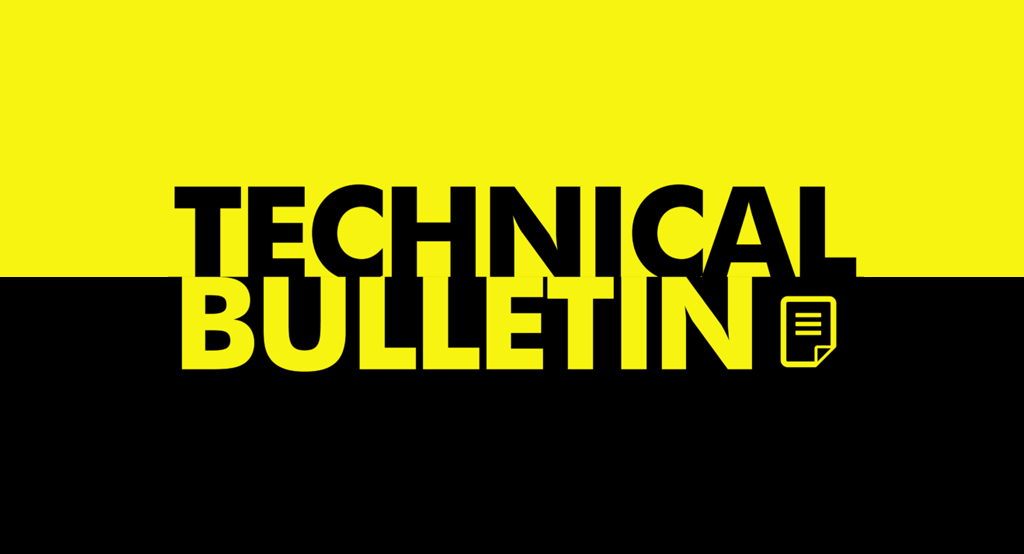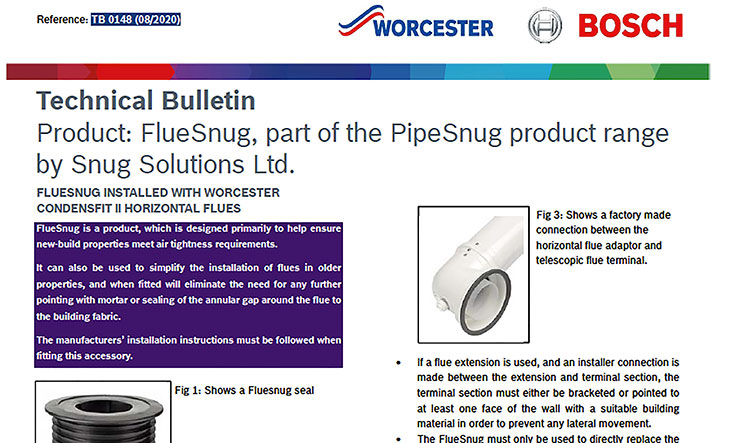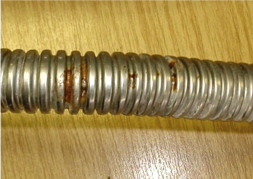
Technical Bulletin 016
Room-sealed flue/chimney terminations – Possible nuisance from fumes and the use of plume management kits. Date issued: August 2017.
This Technical Bulletin deals with the nuisance problem of ‘pluming’ from modern high-efficiency condensing appliances and provides guidance to Gas Safe registered businesses/engineers on termination requirements and the use of plume management kits.
Note: This version of Technical Bulletin 016 replaces the version originally published on 19 August 2010, which is now withdrawn. This version has been reviewed and revised, where appropriate, to ensure that it remains both current and relevant.
Introduction
The Gas Safe Register Technical Helpline regularly receives enquiries about the nuisance caused by the visible plume from modern high-efficiency condensing appliances. These enquiries often relate to a recently fitted appliance that has been installed in close proximity to a property’s boundary or other adjacent properties.
It is therefore important that, at the design stage, Gas Safe registered businesses and engineers carefully consider that the location of all proposed room-sealed flue/chimney terminations is safe, and ensure that combustion products do not cause a nuisance. These are two distinct areas for consideration: remember, the dimensions shown in the appliance manufacturer’s installation instructions are the minimum dimensions required to ensure the safe operation of the appliance and do not ensure that the products of combustion exiting from the termination position will not cause a nuisance to others.
Termination requirements
The primary legislation concerning the safe installation, maintenance and use of gas systems and appliances (in Great Britain – the Gas Safety (Installation and Use) Regulations 1998) in particular, Regulation 27(5), states: “No person shall install a flue other than in a safe position.”
Guidance Note 257 of the Approved Code of Practice and Guidance to the GB GSIUR then states: “A flue (including any terminal) should be installed in a position which ensures that it will operate effectively and that products of combustion will safely disperse and not present a hazard to any person, whether in the premises in which the associated appliance is installed (eg, by being located a safe distance from vents and openable windows), or in adjoining/neighbouring premises. The location needs to take into account any possible developments in neighbouring property, eg, building extensions.”
Guidance Note 258 of the Approved Code of Practice and Guidance to the GB GSIUR states: “Any flue should therefore be sited to discharge at a safe distance from any boundary with adjoining premises (see also Regulation 8). Refer to requirements in Building Regulations, appropriate standards and manufacturers’ instructions.”
Note 1: Similar legislative requirements apply in other geographical areas covered by Gas Safe Register. For details of current gas safety legislation, building legislation and industry standards for the geographical areas covered by Gas Safe Register, see the Legislative, Normative & Informative Document List (LNIDL)(1) by logging into your online account at: https://www.gassaferegister. co.uk/sign-in/
BS 5440-1(2) also provides guidance on the need to site a flue/chimney terminal correctly with regard to a boundary, which is in addition to the minimum safety dimension requirements. The Commentary to Clause 10.2.1 says: “The terminal should be positioned so that the combustion products do not cause a nuisance, for example, the terminal should not be positioned on a passageway, pathway or over adjoining property.”
It is also important to consider that when locating a fanned-draught room-sealed appliance, the position of the terminal should be such as to minimise the risk of the entry of combustion products through openable windows, vents, etc, in opposite or adjacent properties.
BS 5440-1 recommends that room-sealed flue/chimney terminations are positioned:
a) at least 2m measured horizontally from an opening in a building directly opposite, and
b) so that the products of combustion are not directed to discharge across a boundary.
With regard to proximities to boundaries, the flue duct outlet of a gas appliance needs to be sited so that it is at least 600mm from the boundary line when facing it and at least 300mm from the boundary line when running parallel to it. A flue duct outlet can be angled away from the boundary so that the distance between the outlet and the boundary can be maintained to at least 600mm, provided that the shortest distance between the terminal and the boundary is not less that 300mm (see Figure 1).
 With regard to fanned-draught room-sealed appliances, a distance of 600mm from the face of the terminal to a boundary opposite may not be enough to prevent the products of combustion from being considered a nuisance by a neighbouring property. It is therefore preferable that the appliance’s flue/chimney should be routed vertically (through the roof) or can be orientated away from any facing boundary.
With regard to fanned-draught room-sealed appliances, a distance of 600mm from the face of the terminal to a boundary opposite may not be enough to prevent the products of combustion from being considered a nuisance by a neighbouring property. It is therefore preferable that the appliance’s flue/chimney should be routed vertically (through the roof) or can be orientated away from any facing boundary.
Other associated guidance
Guidance is also available in the technical documents that accompany the Building Regulations for England and Wales (Approved Document J(3)), the Scottish Building Standards (Technical Handbook Section 3(4)) and the Building Regulations in Northern Ireland (DFP Technical Booklet L(5)), which all require a flue/chimney terminal to be no closer than 600mm to a property boundary when facing it and no closer than 300mm when running parallel to the boundary (see Note 2).
Note 2: Similar requirements apply in the Isle of Man and Guernsey, where government websites direct the reader to the Approved Documents for Building Regulations in England and Wales for specific guidance (see Note 1). However, it should be noted that the Isle of Man and Guernsey do not necessarily adopt the most current versions of these documents. For further information, guidance should be sought from the relevant Building Control.
Another document that needs to be considered when siting fanned-draught flue/chimney terminals is the ‘Guide to the Condensing Boiler Installation Assessment Procedure for Dwellings’. This document has been written to provide guidance to registered businesses/engineers when carrying out the assessment procedure only – and therefore only applies to existing dwellings where it is considered difficult to replace an existing appliance with a modern condensing appliance.
Note 3: For information about the Guide to the Condensing Boiler Installation Assessment Procedure for Dwellings, refer to TB 023(6) which covers the requirements for England, Wales and Northern Ireland (see also Note 2), and for Scotland see TB 024(7). Log into your online account at: https://www.gassaferegister.co.uk/sign-in/
When carrying out the assessment, the Guides recommend that flue/chimney terminals are positioned no closer than 2.5m to any wall, fence, building or property boundary facing the terminal and no closer than 2.5m to a car parking space unless the flue is more than 2.1m above ground level.
It is important to note that the guidebooks state that it “must not be interpreted as a set of regulations or restrictions on installation practice, nor does it prevail over relevant installation standards or more specific instructions given by the boiler manufacturers”. Therefore, the recommended 2.5m distance will be difficult to enforce.
Where all of the above requirements are considered prior to installation of an appliance, possible nuisance issues should be greatly reduced.
Plume management kits
There will be situations where it is difficult to locate a room-sealed flue/chimney termination with regard to boundary distances, possible entry positions such as openable windows, vents, and nuisance issues. In these circumstances, the installation of a plume management kit, supplied by the boiler manufacturer, may be considered a suitable solution to reduce nuisance.
This situation is common where an existing appliance is to be replaced with a modern high-efficiency appliance and the possibility of nuisance from pluming is increased. It is less likely that a plume management kit would be used in new-build properties as the property developer should have taken all the necessary considerations into their design to ensure the termination position is correct without the need for a plume management kit.
Important: Unless stated in the appliance manufacturer’s installation instructions, a plume management kit should not be used to circumvent the requirement to correctly locate any flue/ chimney termination or air inlet position.
BS 5440-1 – Clause 10.2.1 states: “Plume management kits shall only be used when provided or specified by the appliance manufacturer. They shall be installed such that the resulting chimney outlet is in accordance with Table C.2 and Figure C.8.
“If the plume management kit separates the flue duct and air inlet duct then the position of the flue duct outlet shall remain in the same pressure zone as the air inlet (eg, on the same face of a building) and positioned to avoid the possibility of recirculation of products of combustion.”
When a plume management kit is used, the termination still needs to comply with the current minimum clearances from openings, corners, down pipes, etc, as required by the appliance manufacturer’s installation instructions and BS 5440-1, where referred to by the appliance manufacturer.
It is also important to ensure that the air inlet duct is located correctly as required by the written instructions provided by the appliance manufacturer.
The question of ensuring that both the air inlet duct and flue duct outlet are in the same pressure zone is a difficult one. The example given in BS 5440-1 is that they should be on the same face of the building. However, if for example the air inlet is within a car port but the flue duct outlet is above and outside the car port, this could potentially place the two points in different pressure zones and specialist advice would need to be sought from the appliance manufacturer. Again, this advice should be provided in any subsequent written instructions provided by the appliance manufacturer, a copy of which should be left with the gas user and filed with the appliance manufacturer’s instructions for future reference.
Where any terminal or air inlet is accessible from ground level or if it could be subject to damage, it should be fitted with a protective guard. In the absence of any specific manufacturer’s guidance, a terminal guard needs to be fitted where either the terminal or air inlet is less than 2m above ground, above a balcony or above a flat roof to which people have access.
Conclusion
Any flue/chimney termination position needs to be considered carefully in conjunction with all the available guidance to ensure that the final position chosen is both safe and will not be a nuisance to others.
Although it may be tempting to think that a plume management kit can be used in almost any situation to overcome difficulties with flue/ chimney termination locations, it should not be used to circumvent the requirement to locate the flue/chimney termination position correctly in the first place.
It is also important that where a plume management kit is to be used, it must be installed strictly in accordance with the written instructions provided with the kit by the appliance manufacturer.
The best option is to avoid the issue of nuisance and try to terminate the flue/chimney as high as possible and preferably vertically through the roof of the property, which is now becoming a requirement in a number of European countries.
Note 4: For general information about the process behind the development of Gas Safe Register Technical Bulletins and the expectations for all Stakeholders, see TB 1000(8) by logging into your online account at: https://www.gassaferegister.co.uk/sign-in/
Bibliography
(1) LNIDL – Gas Safe Register Legislative, Normative & Informative Document List
(2) BS 5440-1: 2008 – Flueing and ventilation for gas appliances of rated input not exceeding 70kW net (1st, 2nd and 3rd family gases). Part 1 – Specification for installation of gas appliances to chimneys and for maintenance of chimneys
(3) Approved Document J Combustion appliances and fuel storage systems (England and Wales)
(4) Technical Handbook Section 3 – Environment Domestic (Scotland)
(5) (DFP Technical Booklet L: – Combustion appliances and fuel storage systems (Northern Ireland)
(6) TB 023 – Condensing boiler installation assessment procedure – England, Wales, Northern Ireland, Isle of Man and Guernsey
(7) TB 024 – Condensing Boiler Installation Assessment Procedure (Scotland)
(8) TB 1000 – An introduction to Gas Safe Register Technical Bulletins
Download Technical Bulletin 016 here.


